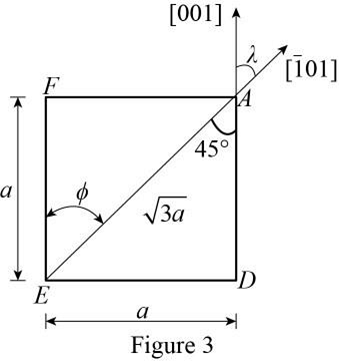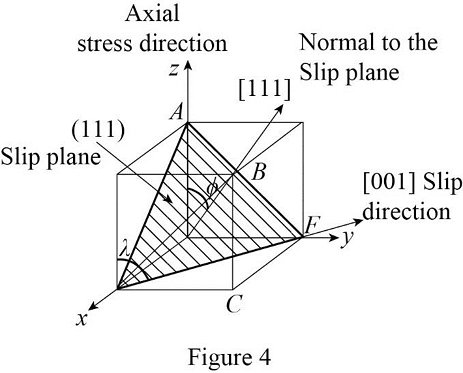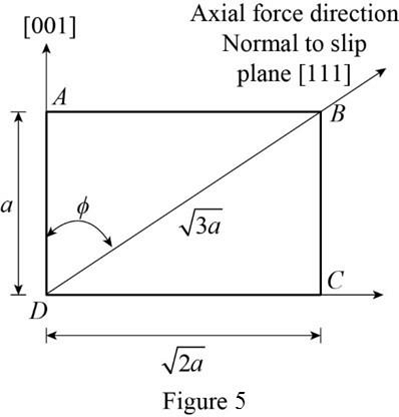
Concept explainers
a)
The resolved shear stress acting on the
a)
Answer to Problem 52AAP
The resolved shear stress acting on the
Explanation of Solution
Write the expression for the Schmidt’s law:
Here,
Conclusion:
Draw the schematic diagram of slip plane and direction of the (111)

Draw the geometry of slip plane (

Draw the geometry of slip plane (

The miller indices of the crystal plane and the direction indices of the normal to a crystal plane are same in the cubic system.
Use the figure (3), if the line AE is bisected the the [001] plane then calculate the angle of EAD.
Calculate the angle between the uniaxial force and normal to the slip plane using the Figure 2.
Substitute
Thus, the resolved shear stress acting on the (111)
b)
The resolved shear stress acting on the
b)
Answer to Problem 52AAP
The resolved shear stress acting on the
Explanation of Solution
Draw the schematic diagram of slip plane and direction of the (111)

Draw the geometry of slip plane (

Refer the Figure 5, the angle between the (111) and [111] are
Calculate the angle between the axial plane [001] and normal slip plane [111]
Substitute
Substitute
Thus, the resolve shear stress acting on the (111)
Want to see more full solutions like this?
Chapter 6 Solutions
Foundations of Materials Science and Engineering
- A single crystal of silver is oriented so that the (111) slip plane is perpendicular to an applied stress of 50 MPa. List the slip systems composed of close-packed planes and directions that may be activated due to this applied stress.arrow_forwardA single crystal of an FCC metal is oriented so that the [001] direction is parallel to an applied stress of 5000 psi. Calculate the resolved shear stress acting on the (111) slip plane in the [-110], and [10-1] slip directions. Which slip system(s) will become active first?arrow_forward6.8 The stress axis in an FCC crystal makes angles of 31◦ and 62◦ with thenormal to the slip plane and with the slip direction, respectively. The appliedstress is 10 MN/m2.arrow_forward
- A single-crystal rod of FCC nickel is oriented with the [001] direction parallel to the rod axis. a. Identify the type of slip system involved in the plastic flow of nickel. b. How many such slip systems are in a position to be activated at the same time when the load is applied parallel to this crystallographic direction? c. What is the Schmid factor for this slip system? (The angles between the {100} and {110} and {100} and {111} planes are 45 and 54.7°, respectively.)arrow_forwardCalculate resolved shear stress on the (111) [01̅1] slip system of a unit cell in an FCC nickel single crystal if a stress of 13.0 GPa is applied in the [001] direction of a unit cell. Draw the diagram for mentioned slip system.arrow_forwardA single crystal of an FCC metal is oriented so that the [001] direction is parallel to an applied stress of 34.47MPa. Calculate the resolved shear stress acting on the (111) slip plane in the [-110], and [10-1] slip directions. Which slip system(s) will become active first?arrow_forward
- Consider a single crystal oriented such that the slip direction and normal to the slip plane are at angles 42.7° and 48.3°, respectively, with the tensile axis. If the critical resolved shear stress is 27.1 MPa, what applied stress (in MPa) will be necessary to cause the single crystal to yield?arrow_forwardDescribe how you would determine the indices of given crystallographic directions.arrow_forwardDetermine the critical resolved shear stress on a BCC single crystal if a normal stress of 10 MPa along [100] direction causes slip system on (110) plan along [1-11], one-bar one-one, direction.arrow_forward
- Magnesium oxide is cubic (having the same structure as NaCl). The slip planes and directions are [110] and <110>, respectively. Along which directions, if any, can a tensile (or compressive) stress be applied without producing slip?arrow_forwardIs there any relationship between a crystal and a grain? justify your answer.arrow_forwardIf we strain an FCC and an HCP single crystal, which of the two will have a larger amount of easy glide, and why?arrow_forward
 Elements Of ElectromagneticsMechanical EngineeringISBN:9780190698614Author:Sadiku, Matthew N. O.Publisher:Oxford University Press
Elements Of ElectromagneticsMechanical EngineeringISBN:9780190698614Author:Sadiku, Matthew N. O.Publisher:Oxford University Press Mechanics of Materials (10th Edition)Mechanical EngineeringISBN:9780134319650Author:Russell C. HibbelerPublisher:PEARSON
Mechanics of Materials (10th Edition)Mechanical EngineeringISBN:9780134319650Author:Russell C. HibbelerPublisher:PEARSON Thermodynamics: An Engineering ApproachMechanical EngineeringISBN:9781259822674Author:Yunus A. Cengel Dr., Michael A. BolesPublisher:McGraw-Hill Education
Thermodynamics: An Engineering ApproachMechanical EngineeringISBN:9781259822674Author:Yunus A. Cengel Dr., Michael A. BolesPublisher:McGraw-Hill Education Control Systems EngineeringMechanical EngineeringISBN:9781118170519Author:Norman S. NisePublisher:WILEY
Control Systems EngineeringMechanical EngineeringISBN:9781118170519Author:Norman S. NisePublisher:WILEY Mechanics of Materials (MindTap Course List)Mechanical EngineeringISBN:9781337093347Author:Barry J. Goodno, James M. GerePublisher:Cengage Learning
Mechanics of Materials (MindTap Course List)Mechanical EngineeringISBN:9781337093347Author:Barry J. Goodno, James M. GerePublisher:Cengage Learning Engineering Mechanics: StaticsMechanical EngineeringISBN:9781118807330Author:James L. Meriam, L. G. Kraige, J. N. BoltonPublisher:WILEY
Engineering Mechanics: StaticsMechanical EngineeringISBN:9781118807330Author:James L. Meriam, L. G. Kraige, J. N. BoltonPublisher:WILEY





